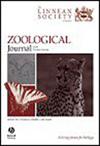New insights into the phylogeny and morphometry of ring nematodes of the subfamily Discocriconemellinae (Nematoda: Criconematidae): Xenocriconemella and Discocriconemella
IF 2.8
2区 生物学
Q1 ZOOLOGY
引用次数: 0
Abstract
In this study, we determine the relevance of applying integrative taxonomic approaches for disentangling the underestimation and real nematode biodiversity of Discocriconemellinae (genera Xenocriconemella and Discocriconemella). Our work suggests a new methodology for studying the species boundaries of cryptic species complexes in soil nematodes, by partitioning the morphological variability into body size and body shape variation components. This methodology is applied to delimit species within cryptic species complexes, such as the Xenocriconemella macrodora complex (including Xenocriconemella tica sp. nov.) and a new species complex in the genus Discocriconemella (including two new species, Discocriconemella costaricense sp. nov. and the morphologically analogous Discocriconemella cryptocostaricense sp. nov.) found in a nematode survey carried out in natural forests in Costa Rica. This revealed that consistently, both X. macrodora and D. costaricense species complexes showed heterogeneity only in shape and not in size. Phylogenetic congruence of these species groups was well supported in the phylogenetic analyses of ribosomal and mitochondrial markers. The genus Xenocriconemella was almost the only one that formed a monophyletic lineage within Criconematidae in ribosomal and mitochondrial phylogenetic trees. However, the genus Discocriconemella, including the two new species, formed a paraphyletic distribution between clades of species of this genus with independent lineages, confirming previous studies.环线虫亚科(线虫纲:环线虫科):异环线虫和环线虫的系统发育和形态形态学新认识
在本研究中,我们确定了应用综合分类学方法来解开对Discocriconemellinae (Xenocriconemella和Discocriconemella)线虫生物多样性的低估和真实生物多样性的相关性。我们的工作为研究土壤线虫隐种复合体的物种边界提供了一种新的方法,即将形态变异划分为身体大小和身体形状变异成分。该方法用于在隐种复合体中划分物种,例如在哥斯达黎加天然林进行的线虫调查中发现的巨dora Xenocriconemella复合体(包括Xenocriconemella tica sp. 11)和Discocriconemella属的一个新种复合体(包括两个新种,Discocriconemella costaricense sp. 11和形态相似的Discocriconemella cryptocostaricense sp. 11)。结果一致表明,大角藻和大角藻的物种复合体只在形状上具有异质性,而在大小上不具有异质性。核糖体和线粒体标记的系统发育分析很好地支持了这些种群的系统发育一致性。在核糖体和线粒体系统发育树中,异锥虫属几乎是锥虫科中唯一形成单系谱系的属。然而,包括这两个新种在内的Discocriconemella属在具有独立谱系的该属种的进化枝之间形成了一种泛葡萄分布,证实了先前的研究。
本文章由计算机程序翻译,如有差异,请以英文原文为准。
求助全文
约1分钟内获得全文
求助全文
来源期刊
CiteScore
6.50
自引率
10.70%
发文量
116
审稿时长
6-12 weeks
期刊介绍:
The Zoological Journal of the Linnean Society publishes papers on systematic and evolutionary zoology and comparative, functional and other studies where relevant to these areas. Studies of extinct as well as living animals are included. Reviews are also published; these may be invited by the Editorial Board, but uninvited reviews may also be considered. The Zoological Journal also has a wide circulation amongst zoologists and although narrowly specialized papers are not excluded, potential authors should bear that readership in mind.

 求助内容:
求助内容: 应助结果提醒方式:
应助结果提醒方式:


